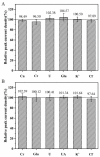Sensitivity Detection of Uric Acid and Creatinine in Human Urine Based on Nanoporous Gold
- PMID: 36004983
- PMCID: PMC9405689
- DOI: 10.3390/bios12080588
Sensitivity Detection of Uric Acid and Creatinine in Human Urine Based on Nanoporous Gold
Abstract
Given the significance of uric acid and creatinine in clinical diagnostic, disease prevention and treatment, a multifunctional electrochemical sensor was proposed for sensitive detection of uric acid and creatinine. The sensitive detection of uric acid was realized based on the unique electrochemical oxidation of nanoporous gold (NPG) towards uric acid, showing good linearity from 10 μM to 750 μM with a satisfactory sensitivity of 222.91 μA mM-1 cm-2 and a limit of detection (LOD) of 0.06 μM. Based on the Jaffé reaction between creatinine and picric acid, the sensitive detection of creatinine was indirectly achieved in a range from 10 to 2000 μM by determining the consumption of picric acid in the Jaffé reaction with a detection sensitivity of 195.05 μA mM-1 cm-2 and a LOD of 10 μM. For human urine detection using the proposed electrochemical sensor, the uric acid detection results were comparable to that of high-performance liquid chromatography (HPLC), with a deviation rate of less than 10.28% and the recoveries of uric acid spiked in urine samples were 89~118%. Compared with HPLC results, the deviation rate of creatinine detection in urine samples was less than 4.17% and the recoveries of creatinine spiked in urine samples ranged from 92.50% to 117.40%. The multifunctional electrochemical sensor exhibited many advantages in practical applications, including short detection time, high stability, simple operation, strong anti-interference ability, cost-effectiveness, and easy fabrication, which provided a promising alternative for urine analysis in clinical diagnosis.
Keywords: co-catalytic strategy; creatinine; human urine; nanoporous gold; uric acid.
Conflict of interest statement
The authors declare that they have no known competing financial interests or personal relationships that could have appeared to influence the work reported in this paper.
Figures






Similar articles
-
Rapid Detection of the Anti-Tumor Drug Etoposide in Biological Samples by Using a Nanoporous-Gold-Based Electrochemical Sensor.Molecules. 2024 Feb 28;29(5):1060. doi: 10.3390/molecules29051060. Molecules. 2024. PMID: 38474572 Free PMC article.
-
The development of NAD+-dependent dehydrogenase screen-printed biosensor based on enzyme and nanoporous gold co-catalytic strategy.Biosens Bioelectron. 2022 Sep 1;211:114376. doi: 10.1016/j.bios.2022.114376. Epub 2022 May 17. Biosens Bioelectron. 2022. PMID: 35598555
-
Sensitive electrochemical detection of cholesterol using a portable paper sensor based on the synergistic effect of cholesterol oxidase and nanoporous gold.Int J Biol Macromol. 2021 Oct 31;189:356-362. doi: 10.1016/j.ijbiomac.2021.08.145. Epub 2021 Aug 24. Int J Biol Macromol. 2021. PMID: 34450139
-
Ultradense Electrochemical Chips with Arrays of Nanostructured Microelectrodes to Enable Sensitive Diffusion-Limited Bioassays.ACS Appl Mater Interfaces. 2025 Mar 5;17(9):13037-13049. doi: 10.1021/acsami.4c01159. Epub 2024 Mar 27. ACS Appl Mater Interfaces. 2025. PMID: 38537173 Review.
-
Trend in creatinine determining methods: Conventional methods to molecular-based methods.Anal Sci Adv. 2020 Oct 20;2(5-6):308-325. doi: 10.1002/ansa.202000074. eCollection 2021 Jun. Anal Sci Adv. 2020. PMID: 38716155 Free PMC article. Review.
Cited by
-
Electrochemical Nanosensors for Sensitization of Sweat Metabolites: From Concept Mapping to Personalized Health Monitoring.Molecules. 2023 Jan 27;28(3):1259. doi: 10.3390/molecules28031259. Molecules. 2023. PMID: 36770925 Free PMC article. Review.
-
Rapid Detection of the Anti-Tumor Drug Etoposide in Biological Samples by Using a Nanoporous-Gold-Based Electrochemical Sensor.Molecules. 2024 Feb 28;29(5):1060. doi: 10.3390/molecules29051060. Molecules. 2024. PMID: 38474572 Free PMC article.
-
Advances in Surface-Enhanced Raman Spectroscopy for Urinary Metabolite Analysis: Exploiting Noble Metal Nanohybrids.Biosensors (Basel). 2024 Nov 21;14(12):564. doi: 10.3390/bios14120564. Biosensors (Basel). 2024. PMID: 39727829 Free PMC article. Review.
-
A dual-functional nanogold tablet as a plasmonic and nanozyme sensor for point-of-care applications.Nanoscale Adv. 2025 Mar 20;7(10):2967-2978. doi: 10.1039/d5na00082c. eCollection 2025 May 13. Nanoscale Adv. 2025. PMID: 40177386 Free PMC article.
-
Integration of Glutamate Dehydrogenase and Nanoporous Gold for Electrochemical Detection of Glutamate.Biosensors (Basel). 2023 Dec 10;13(12):1023. doi: 10.3390/bios13121023. Biosensors (Basel). 2023. PMID: 38131783 Free PMC article.
References
-
- Yang Y.D. Simultaneous determination of creatine, uric acid, creatinine and hippuric acid in urine by high performance liquid chromatography. Biomed. Chromatogr. 1998;12:47–49. - PubMed
-
- Hernandez-Ramirez D., Mendoza-Huizar L.H., Galan-Vidal C.A., Aguilar-Lira G.Y., Alvarez-Romero G.A. Review-trends in the development of non-enzymatic electrochemical sensors modified with a metal-organic framework for quantification of uric acid. J. Electrochem. Soc. 2022;169:057522. doi: 10.1149/1945-7111/ac6c0d. - DOI
-
- Roopa R.A., Mantelingu K., Guin M., Thimmaiah S.B. Bienzymatic spectrophotometric method for uric acid estimation in human serum and urine. J. Anal. Chem. 2022;77:301–307. doi: 10.1134/S1061934822030091. - DOI
MeSH terms
Substances
Grants and funding
LinkOut - more resources
Full Text Sources

